Morning Eye Candy: A Frill A Minute
Posted in Photography on March 26 2013, by Ann Rafalko
It’s a frilly affair at The Orchid Show!


Inside The New York Botanical Garden
Posted in Photography on March 26 2013, by Ann Rafalko
It’s a frilly affair at The Orchid Show!

Posted in Photography on March 25 2013, by Ann Rafalko
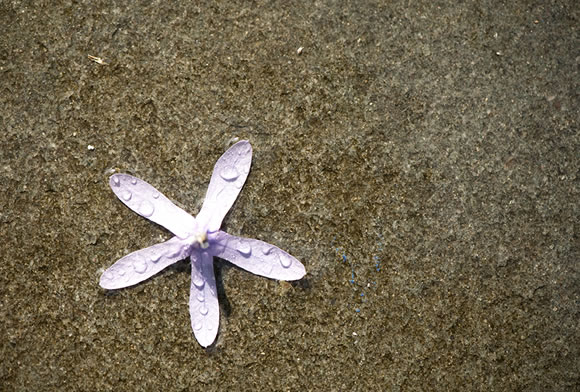
In the Aquatic Plants Gallery (photo by Ivo M. Vermeulen)
Posted in Photography on March 24 2013, by Ann Rafalko
If you look close enough, the orchids in The Orchid Show begin to look like modern art.
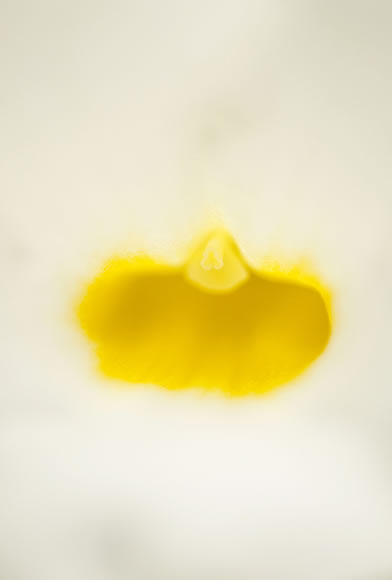
Photo by Ivo M. Vermeulen
Posted in Photography on March 23 2013, by Ann Rafalko
So, the root of the matter is this: It somehow is still not spring outside. Never fear! The Enid A. Haupt Conservatory is a tropical paradise right now. It’s spring inside!

Photo by Ivo M. Vermeulen
Posted in Bill Buck, From the Field, Science on March 18 2013, by William R. Buck
January 30-31, 2013 Punta Arenas, Chile
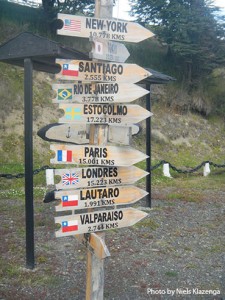 Our projected travel time back to Punta Arenas from Puerto Williams is 43 hours. But, before we set out, we have one last stop to make. Ernesto has arranged for us a private tour of the Museo Antropológico Martin Gusinde with the museum’s director, another one of his friends, naturally. I toured the museum once about 10 years ago, but no one else on the trip has visited it before. The museum has a two-fold focus, documenting the culture of the Yaghan people and presenting the history of European exploration in the region. It is a well-maintained museum and quite the tourist attraction despite all the exhibits being presented solely in Spanish. The namesake of the museum, Martin Gusinde, was an Austrian priest who lived for extended periods with the Yahgan and documented their social and spiritual life in the early 1930s through photography and ethnography. It is a surprising little museum with well curated and exhaustive exhibits. I am glad to get the refresher course in both of the museum’s foci.
Our projected travel time back to Punta Arenas from Puerto Williams is 43 hours. But, before we set out, we have one last stop to make. Ernesto has arranged for us a private tour of the Museo Antropológico Martin Gusinde with the museum’s director, another one of his friends, naturally. I toured the museum once about 10 years ago, but no one else on the trip has visited it before. The museum has a two-fold focus, documenting the culture of the Yaghan people and presenting the history of European exploration in the region. It is a well-maintained museum and quite the tourist attraction despite all the exhibits being presented solely in Spanish. The namesake of the museum, Martin Gusinde, was an Austrian priest who lived for extended periods with the Yahgan and documented their social and spiritual life in the early 1930s through photography and ethnography. It is a surprising little museum with well curated and exhaustive exhibits. I am glad to get the refresher course in both of the museum’s foci.
Posted in Bill Buck, From the Field, Science on March 15 2013, by William R. Buck
January 28, 2013, Prov. Antártica Chilena, Comuna Cabo de Hornos, Isla Navarino, Puerto Williams, 54°56’S, 67°37’W
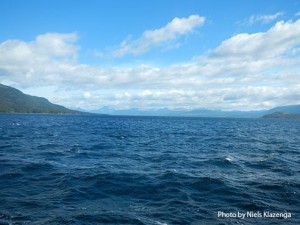 The engines start up again at 6 a.m. and quite soon we arrive at Caleta Piedras on Isla Pictón. We knew ahead of time that today would be an early day of collecting because we need to also get back to Puerto Williams to gather up the specimens we left behind there. What we didn’t know was that there would be a substantial metal dock at this site, and a house flying the Chilean flag, too. The house is empty now, but presumably occupied seasonally.
The engines start up again at 6 a.m. and quite soon we arrive at Caleta Piedras on Isla Pictón. We knew ahead of time that today would be an early day of collecting because we need to also get back to Puerto Williams to gather up the specimens we left behind there. What we didn’t know was that there would be a substantial metal dock at this site, and a house flying the Chilean flag, too. The house is empty now, but presumably occupied seasonally.
Posted in Bill Buck, From the Field, Science on March 14 2013, by William R. Buck
January 27, 2013, Prov. Antártica Chilena, Comuna Cabo de Hornos, Isla Navarino, Puerto Toro, 55°05’S, 67°04’W
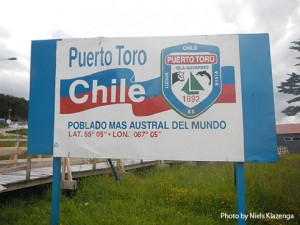 This morning I am not alone in rising early. Today is our only opportunity to go into the field on Isla Lennox. It is so warm and sunny that it is hard to decide on an appropriate outfit, one that is not too heavy and yet still waterproof when sitting on the ground. The plan is to spread out so as to cover as much of this substantial island as possible, all the while avoiding landmines.
This morning I am not alone in rising early. Today is our only opportunity to go into the field on Isla Lennox. It is so warm and sunny that it is hard to decide on an appropriate outfit, one that is not too heavy and yet still waterproof when sitting on the ground. The plan is to spread out so as to cover as much of this substantial island as possible, all the while avoiding landmines.
Laura and I decide to work our way along what appears to be a river, but is indicated as an inlet of the sea on our map. The tannic water flowing down into the sea seems to indicate that it is at the very least brackish. It is not rich in moss flora, at least where I am, but I do find a few species of Ulota. Last year one of our traveling companions was Ricardo Garilleti, who is working on this genus in southern South America. Not only is Ricardo a great traveling companion, but he taught me how to be a better collector of this most frequently-encountered genus of epiphytes in this region. Without his knowledge I never would have guessed that different species of Ulota prefer different substrate, especially in terms of Berberis versus Nothofagus.
Posted in Bill Buck, From the Field, Science on March 13 2013, by William R. Buck
January 26, 2013, Prov. Antártica Chilena, Comuna Cabo de Hornos, Isla Lennox, Caleta Lennox, 55°18’S, 66°51’W
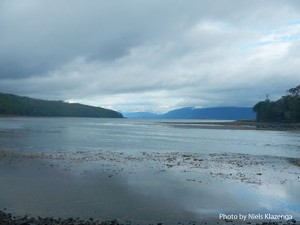 At 3:30 a.m. I hear the engine shut down, so I venture out onto the deck to see if we have arrived at our destination after taking the long way around. And in fact, we have arrived at Isla Pictón, the northernmost island of the grouping of Pictón, Lennox, and Nueva islands, and the last of our targeted areas for this year. Each of these islands still houses a naval outpost, left from a time in the 1970s when Chile anticipated Argentina would invade them. To this day, Juan feels pride in the fact that Chile defended these three islands and still holds them. On the downside, Chile also land-mined parts of the islands as part of their defense. This accounts at least in part for all the security and the hassles to get permission to visit them.
At 3:30 a.m. I hear the engine shut down, so I venture out onto the deck to see if we have arrived at our destination after taking the long way around. And in fact, we have arrived at Isla Pictón, the northernmost island of the grouping of Pictón, Lennox, and Nueva islands, and the last of our targeted areas for this year. Each of these islands still houses a naval outpost, left from a time in the 1970s when Chile anticipated Argentina would invade them. To this day, Juan feels pride in the fact that Chile defended these three islands and still holds them. On the downside, Chile also land-mined parts of the islands as part of their defense. This accounts at least in part for all the security and the hassles to get permission to visit them.
Posted in Bill Buck, From the Field, Science on March 12 2013, by William R. Buck
January 25, 2013, Prov. Antártica Chilena, Comuna Cabo de Hornos, Isla Navarino, Seno Grandi, 55°14’S, 67°46’W
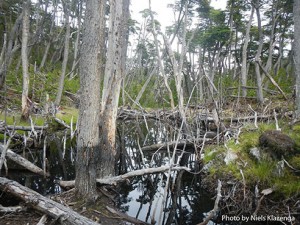 The ship begins moving in the early morning hours and the potentially rough seas never really materialize. I think for most of us it is instead like being rocked in a cradle. When we stop we are halfway up the north side of Seno Grandi. Our collecting site is along a large river that empties into a lake. About half of us go up the east side of the river, and the rest to the west. Although not cold or raining, a steady strong wind makes the Zodiac trip ashore wet and rough. As we approach the shore we can see quite clearly that the landscape is heavily disturbed. There are remnants of abandoned dwellings and piles of crab traps. It appears that beaver have caused significant damage to the landscape as well, and that the large peatland to the west of the river is courtesy of an ancient beaver dam.
The ship begins moving in the early morning hours and the potentially rough seas never really materialize. I think for most of us it is instead like being rocked in a cradle. When we stop we are halfway up the north side of Seno Grandi. Our collecting site is along a large river that empties into a lake. About half of us go up the east side of the river, and the rest to the west. Although not cold or raining, a steady strong wind makes the Zodiac trip ashore wet and rough. As we approach the shore we can see quite clearly that the landscape is heavily disturbed. There are remnants of abandoned dwellings and piles of crab traps. It appears that beaver have caused significant damage to the landscape as well, and that the large peatland to the west of the river is courtesy of an ancient beaver dam.
Posted in Bill Buck, From the Field, Science on March 11 2013, by William R. Buck
January 24, 2013, Prov. Antártica Chilena, Comuna Cabo de Hornos, Isla Hoste, Canal Canacus, 55°13’S, 68°21’W
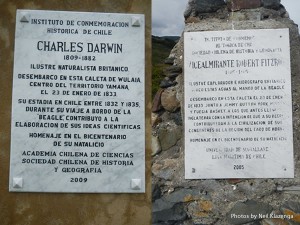 We leave Puerto Inútil about 7 a.m. and arrive at Wulaia a half-hour later. This is one of the most famous sites in the region and one I have visited several times. Charles Darwin arrived here on January 23, 1833, 180 years ago–minus one day–today. The site has changed considerably since my last visit. There is now a metal dock for unloading cruise ship passengers, and a large, old slaughterhouse has been transformed into a museum which is open when cruise ships arrive. A plaque celebrating Darwin was put up in 2009 on the occasion of the 200th anniversary of his birth. There is also a plaque commemorating Robert FitzRoy, the captain of the HMS Beagle and a pioneering scientist in his own right.
We leave Puerto Inútil about 7 a.m. and arrive at Wulaia a half-hour later. This is one of the most famous sites in the region and one I have visited several times. Charles Darwin arrived here on January 23, 1833, 180 years ago–minus one day–today. The site has changed considerably since my last visit. There is now a metal dock for unloading cruise ship passengers, and a large, old slaughterhouse has been transformed into a museum which is open when cruise ships arrive. A plaque celebrating Darwin was put up in 2009 on the occasion of the 200th anniversary of his birth. There is also a plaque commemorating Robert FitzRoy, the captain of the HMS Beagle and a pioneering scientist in his own right.